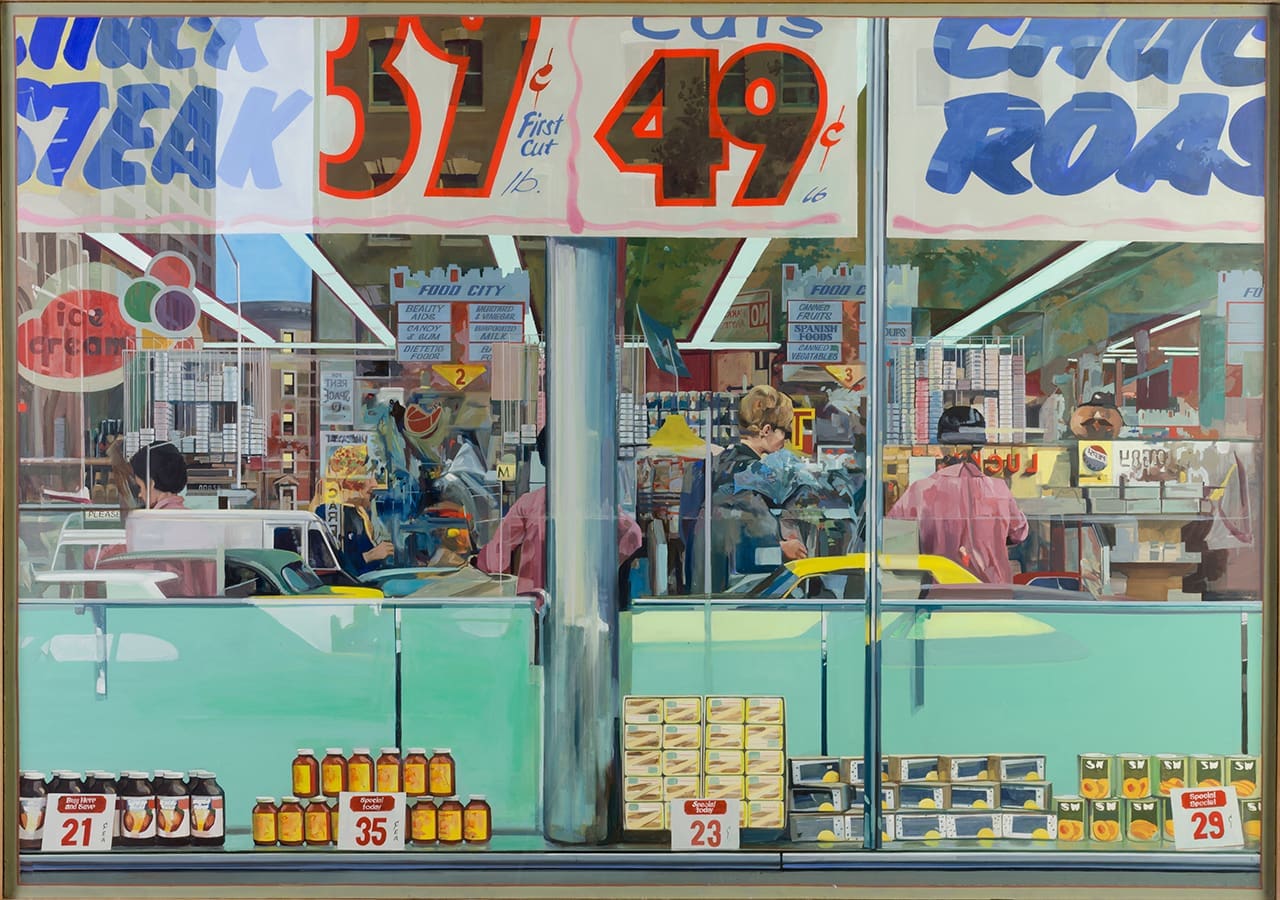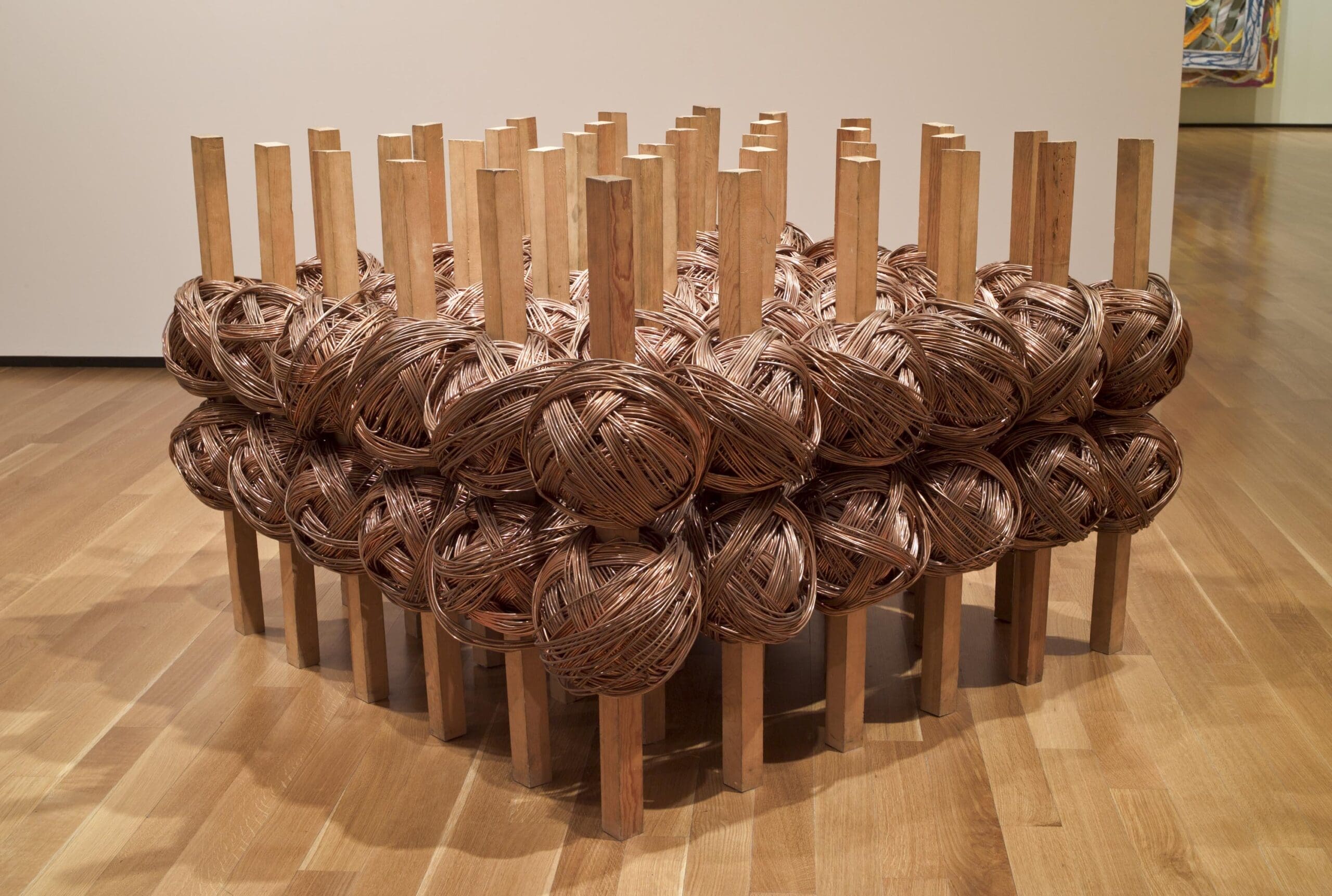Category: Artwork
Unchanged: Seascapes
The photographer Hiroshi Sugimoto asked himself “What would be the most unchanged scene on the surface of the earth?”
HEAVY METAL
Time to rock out to some heavy metal — sculpture style. Let’s take a tour of three metal artworks that are both beautiful and hardcore.
Close Looking
Let’s take this opportunity to get close and take a look at the details of some favorite works.
Collection Feature: Richard Estes, Food City
Food City verges on abstraction, as colors, shapes and brushstrokes intermingle. Cars, taxis and vans flatten into the same space as the cashier’s pink uniform, the checkout counters and stacks of cigarette packs. The facades of multistory buildings merge with hand-lettered signs advertising chuck steaks at 39 cents a pound. Richard Estes crops his painting so the grocery store’s glass windows fill the entire composition. Exterior and interior elements dissolve into a single plane. This energetic visual potpourri mimics the vitality of the surrounding New
Collection Feature: Jackie Winsor, #2 Copper
Jackie Winsor (born 1941, St. John’s Island, Newfoundland, Canada) assembles sculptures out of unexpected components. She prefers organic materials such as rope, hemp, branches and logs or building supplies like concrete, nails and bricks. Not one to shy away from difficult physical work, Winsor constructs her minimalist geometric forms through repetitive manual labor. For #2 Copper, the artist built a grid out of 36 narrow pieces of wood, arranged in three sections of concentric squares. She wrapped each intersection with #2 industrial copper wire, forming
A Conversation with Erin Guido & John Paul Costello
Erin Guido creates brightly colored dynamic shape and text murals often found in surprising places, like abandoned buildings, offering friendly encouragement as they declare “come over all the time” or “hi.” With the help of carpenter John Paul Costello, Guido’s works became durable, movable pieces, such as “How Are You Feeling Today?” a large sculpture that asks visitors to dial in their emotions. How are you feeling today?EG: I am feeling pretty good today!JP: Today as with most days lately I’m feeling a bit stressed
A Conversation with Horrible Adorables Artists Jordan Elise Perme and Christopher Lees
Jordan Elise Perme and Christopher Lees create mounted animal sculptures they call Horrible Adorables and design patterns for fabric and wallpaper as well as plastic toys for Kid Robot. Can you talk about your Horrible Adorable characters? Horrible Adorables are strange creatures from a fantastical land. They are hybrids of selected animals, and have qualities that are both sinister and sweet (horrible and adorable, if you will). We bring the imaginary critters to life by hand carving foam forms, covering them with wool felt scales,
A Conversation with Please Touch Artist Jay Croft
Interview conducted by Alison Caplan, Akron Art Museum Director of Education Inspired by skateboarding and D.I.Y. culture, Jay Croft’s illustrations have donned skateboard decks, his zine Street Canoe, and most recently, a mural at Chill Ice Cream. Can you talk about being a parent and an artist? It’s the best thing ever! I love it. My kids are always drawing and making stuff. We definitely encourage them to create. Our house is filled with all types of markers, paint, papers, and glue. I encourage them
An Interview With Our Land Artist, Bob Herbst
Interview conducted by Theresa Bembnister, Akron Art Museum Associate CuratorAkron Art Museum: Can you explain to me your interest in photographing the American West, specifically the national parks?Bob Herbst: In 1993 I decided to take a photography workshop in southern Utah which involved camping out in the desert and photographing for a week. My wife and I were raised in camping-oriented families and had done canoeing expeditions for the 10 years prior in Algonquin Provincial Park in Ontario, so it sounded like something I would enjoy.
NEO Geo Studio Visits
By Theresa Bembnister, Associate CuratorIf philosopher Alan Watts is right, and museums are the places art goes to die, then the artist’s studio must surely be the birthplace of a work of art.For the record: I disagree with Watts. But I do relish the opportunity to see art in its native studio environment, before it’s displayed on the museum’s pristine walls. The context of an artist’s workspace offers clues as to how or why a particular artwork was made.Studio visits made up a large part







